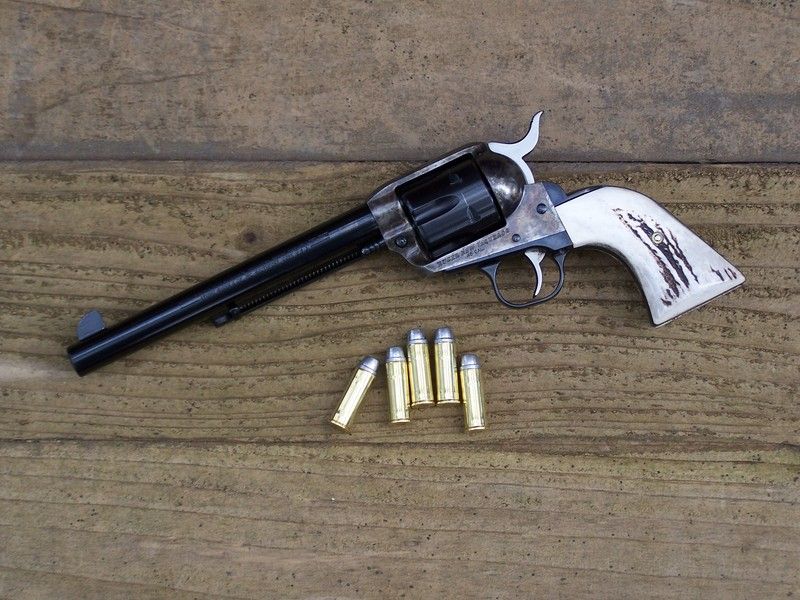You are using an out of date browser. It may not display this or other websites correctly.
You should upgrade or use an alternative browser.
You should upgrade or use an alternative browser.
Case Hardened Vaquero?
- Thread starter sixgunnin
- Start date
Bob Wright
New member
Some early production New Vaqueros had the color case hardened finish, but that was soon discontinued.
So far as I know, that only adds a slight premium to the price for now. Likely will increase in the next hundred years or so.
Bob Wright
So far as I know, that only adds a slight premium to the price for now. Likely will increase in the next hundred years or so.
Bob Wright
Blued or SS only now.
Those early models had a colour case finish vs actual case hardening. Argued about here in 2009.
https://thefiringline.com/forums/showthread.php?t=364444
Those early models had a colour case finish vs actual case hardening. Argued about here in 2009.
https://thefiringline.com/forums/showthread.php?t=364444
Bob Wright
New member
Driftwood Johnson
New member
Howdy
This is an early 'original model' Vaquero. It was made in 1994. It has the Ruger 'color case' finish. Which as has already been stated was not real Case Hardening, it was a chemical wash.
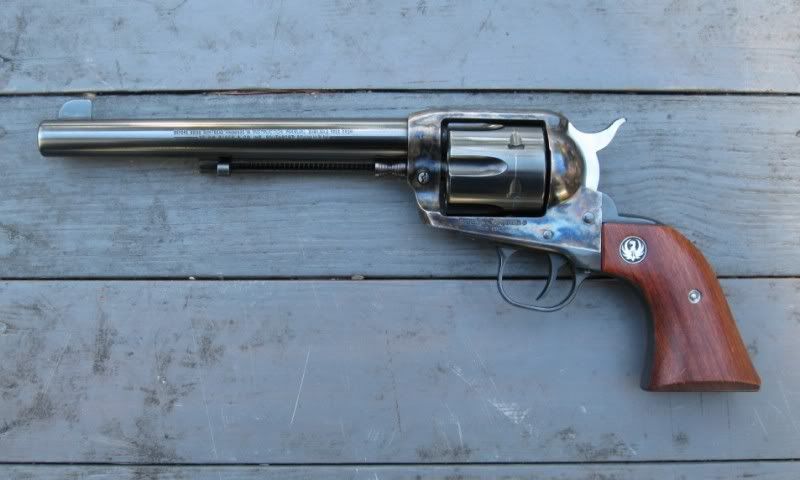
The 'original model' Vaquero was nothing more than a New Model Blackhawk with the frame contoured to resemble a Colt Single Action Army. The front sight was replaced with a simple blade like the Colt and the adjustable rear sight was replaced with a fixed sight groove down the center of the top strap, also similar to a Colt. But other than that, the 'original model' Vaquero was nothing more than Blackhawk with a re-contoured top strap. And the grip frame was steel, unlike the aluminum grip frame of the Blackhawk. I can clearly remember when I first bought the Blackhawk in the first photo that it felt kind of heavy. Sure enough, when I got it home a magnet showed me the grip frame was steel, unlike the grip frame of my old New Model Blackhawk that I bought in 1975.

This is an early New Vaquero. It was made in 2006 when Ruger was still finishing them with the 'color case' finish. Ruger stopped putting this finish on the New Vaqueros shortly after this one was made because there were a lot of complaints about the finish causing rust. For what it's worth, I have two of these, in addition to my 'original model' Vaquero and I have never had a problem with the finish rusting on any of them.
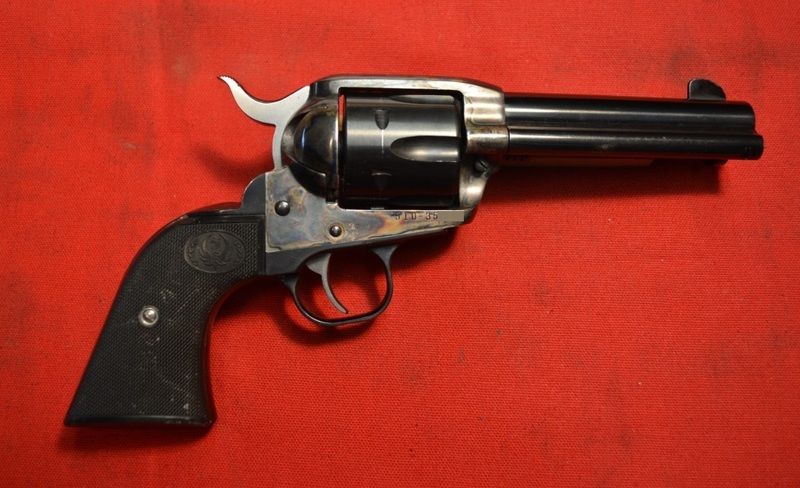
"So why the change to the long spur with the New Vaquero, for the Cowboy Action Shooters?"
Because that is what shooters were asking for. Shooters were complaining about how big the 'original model' Vaquero was, significantly bigger than a Colt. So the New Vaquero was introduced in 2005 and the 'original model' Vaquero was discontinued at the same time. One of the features of the New Vaquero, along with being the same size as a Colt, was the longer hammer spur, very similar to a Colt. That's what shooters were asking for. In addition to the change in the hammer shape, the cylinder pin was shortened, so it could be removed from the gun without removing the ejector rod housing. You could not do that with a Blackhawk or an 'original model' Vaquero. This also meant that you could loose the cylinder pin in the grass if you weren't careful, just like you can with a Colt.
About that longer hammer spur: with a Blackhawk or an 'original model' Vaquero the hammer spur was short enough that the gun could be sighted with the hammer down. You can't do that with a Colt, the spur is too long and is in the way. You have to cock the hammer to see the sights. Same with the New Vaquero when it first came out, you had to cock the hammer to see the sights. Other hammers are available now, but what's the point? It's a single action revolver. You can't shoot the thing until you cock the hammer, so what does it matter that you could see the sights with hammer down?
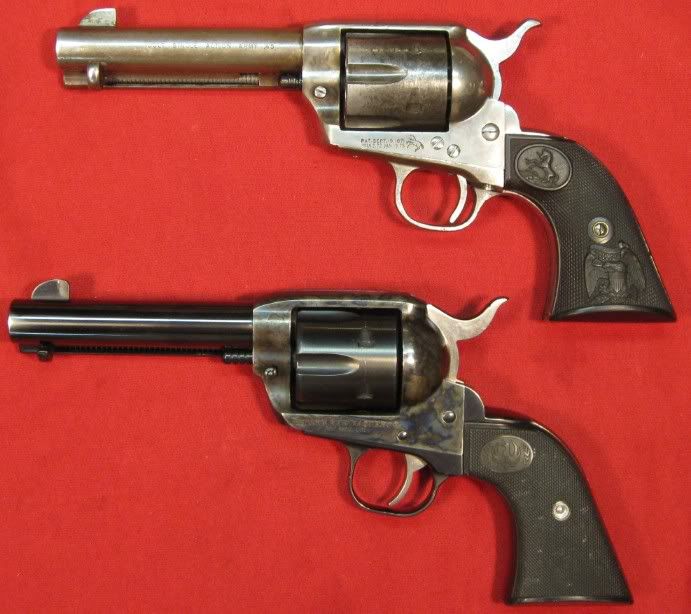
Of course, people being people, as soon as the New Vaquero appeared, there was an immediate hue and cry for the old model, despite the fact that Ruger gave shooters exactly what they had been asking for. A single action revolver that more closely resembled a Colt.
Oh yeah, there was a lock hidden down inside the grip frame, but unlike S&W it was completely invisible unless you drilled an access hole for it in the grips. They even provided a dimple on the inside of the grips to show you where to drill. Or you could completely ignore the lock like most of us did.
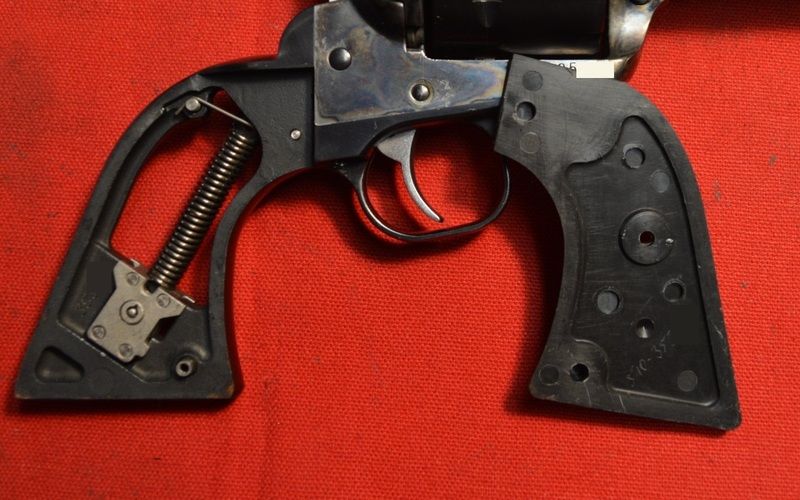
This is an early 'original model' Vaquero. It was made in 1994. It has the Ruger 'color case' finish. Which as has already been stated was not real Case Hardening, it was a chemical wash.

The 'original model' Vaquero was nothing more than a New Model Blackhawk with the frame contoured to resemble a Colt Single Action Army. The front sight was replaced with a simple blade like the Colt and the adjustable rear sight was replaced with a fixed sight groove down the center of the top strap, also similar to a Colt. But other than that, the 'original model' Vaquero was nothing more than Blackhawk with a re-contoured top strap. And the grip frame was steel, unlike the aluminum grip frame of the Blackhawk. I can clearly remember when I first bought the Blackhawk in the first photo that it felt kind of heavy. Sure enough, when I got it home a magnet showed me the grip frame was steel, unlike the grip frame of my old New Model Blackhawk that I bought in 1975.

This is an early New Vaquero. It was made in 2006 when Ruger was still finishing them with the 'color case' finish. Ruger stopped putting this finish on the New Vaqueros shortly after this one was made because there were a lot of complaints about the finish causing rust. For what it's worth, I have two of these, in addition to my 'original model' Vaquero and I have never had a problem with the finish rusting on any of them.

"So why the change to the long spur with the New Vaquero, for the Cowboy Action Shooters?"
Because that is what shooters were asking for. Shooters were complaining about how big the 'original model' Vaquero was, significantly bigger than a Colt. So the New Vaquero was introduced in 2005 and the 'original model' Vaquero was discontinued at the same time. One of the features of the New Vaquero, along with being the same size as a Colt, was the longer hammer spur, very similar to a Colt. That's what shooters were asking for. In addition to the change in the hammer shape, the cylinder pin was shortened, so it could be removed from the gun without removing the ejector rod housing. You could not do that with a Blackhawk or an 'original model' Vaquero. This also meant that you could loose the cylinder pin in the grass if you weren't careful, just like you can with a Colt.
About that longer hammer spur: with a Blackhawk or an 'original model' Vaquero the hammer spur was short enough that the gun could be sighted with the hammer down. You can't do that with a Colt, the spur is too long and is in the way. You have to cock the hammer to see the sights. Same with the New Vaquero when it first came out, you had to cock the hammer to see the sights. Other hammers are available now, but what's the point? It's a single action revolver. You can't shoot the thing until you cock the hammer, so what does it matter that you could see the sights with hammer down?

Of course, people being people, as soon as the New Vaquero appeared, there was an immediate hue and cry for the old model, despite the fact that Ruger gave shooters exactly what they had been asking for. A single action revolver that more closely resembled a Colt.
Oh yeah, there was a lock hidden down inside the grip frame, but unlike S&W it was completely invisible unless you drilled an access hole for it in the grips. They even provided a dimple on the inside of the grips to show you where to drill. Or you could completely ignore the lock like most of us did.

disseminator
New member
Great thread, i enjoy learning about my guns.
I have an original Vaquero made in 94. It has the case hardened finish and has never rusted or faded as of yet with around 1000 rounds through it since I got it used in trade for another gun.
It's one of my favorites in 45 Colt and I will never sell it.
I have an original Vaquero made in 94. It has the case hardened finish and has never rusted or faded as of yet with around 1000 rounds through it since I got it used in trade for another gun.
It's one of my favorites in 45 Colt and I will never sell it.
I have an original Vaquero made in 94. It has the case hardened finish
As has been said, the finish on your Ruger Vaquero is not case hardened, it is case "colored"- a very big difference indeed.
disseminator
New member
I am aware. It is STILL a case hardened finish.
Some alloy framed pistols are sold with a stainless finish. It is understood it's not real stainless.
But it is a stainless finish none the less.

Some alloy framed pistols are sold with a stainless finish. It is understood it's not real stainless.
But it is a stainless finish none the less.
I do not understand. When you say "alloy framed", what "alloy" are you talking about? A Carbon Steel alloy? A Pot Metal Alloy? "Alloy" just means a blend of two or more metals.Some alloy framed pistols are sold with a stainless finish. It is understood it's not real stainless.
But it is a stainless finish none the less.
Also, what is a "stainless finish"? Is there some gun out there that has a Carbon steel frame overlaid/plated/or coated somehow with Stainless Steel?
Colors produced by some chemical reaction on a gun is NOT "case hardened". Case hardening is produced by taking a low or medium carbon steel and infusing carbon into its surface and then quenching resulting in a thin layer of hard (and colored), surface. Chemicals do not infuse carbon or harden the surface unless Nitriding. If you disagree, please straighten me out so that I can add to my education.I am aware. It is STILL a case hardened finish.
Color produced sans Carbon infusion produce a finish that more correctly could be called a "Faux Case Hardened Finish"...but it sure as hell ain't "Color Case Hardened."
Driftwood Johnson
New member
Howdy
In the world of firearms, alloy frame usually means aluminum. Yes, Steel is an alloy, and in chemistry, alloy means a blend of two or more elemental metals, but in the world of firearms the word usually means aluminum.
I am trying to remember exactly what Ruger called their fake case color finish. They most definitely did not call it Case Hardened because they knew it was not true Case Hardening. Case Hardening is a method of infusing extra carbon into the surface of iron or low carbon steel to harden the outer surface or Case. I seem to recall they called it something like Color Case finish, or something like that, to get around the fact that it was not real Case Hardening.
In the world of firearms, alloy frame usually means aluminum. Yes, Steel is an alloy, and in chemistry, alloy means a blend of two or more elemental metals, but in the world of firearms the word usually means aluminum.
I am trying to remember exactly what Ruger called their fake case color finish. They most definitely did not call it Case Hardened because they knew it was not true Case Hardening. Case Hardening is a method of infusing extra carbon into the surface of iron or low carbon steel to harden the outer surface or Case. I seem to recall they called it something like Color Case finish, or something like that, to get around the fact that it was not real Case Hardening.
Driftwood Johnson
New member
I have a original Vaquero and the first owner got a cleaner of some soret on the case color and it striped the color off on a dime sised spot,
The colors of true Case Hardening are quite fragile too. They tend to fade over time. Bright sunlight will cause the colors to fade over time. Naval Jelly will remove the colors of real Case Hardening in a jiffy. The hardened layer of steel will still be there, but the colors will disappear.
The 'color case' finish Ruger applied did not harden the metal. Ruger heat treats their frames so they are hardened all the way through, unlike Case Hardening that only hardens the surface. The 'color case' finish Ruger used to apply only left colors on the surface, it did not harden anything.
jackmoser65
New member
Ruger, like Uberti, Pietta, etc., used a chemical process to simply "color" their frames.
There are different traditional ways to color case harden steel parts. One of which does involve a chemical, cyanide.
There are also ways to add authentic colors through a pseudo-traditional bone charcoal process without actually hardening. This is what Turnbull does with Ruger frames. Real colors, traditional bone charcoal process, no hardening.
There are different traditional ways to color case harden steel parts. One of which does involve a chemical, cyanide.
There are also ways to add authentic colors through a pseudo-traditional bone charcoal process without actually hardening. This is what Turnbull does with Ruger frames. Real colors, traditional bone charcoal process, no hardening.
disseminator
New member
I do not understand. When you say "alloy framed", what "alloy" are you talking about? A Carbon Steel alloy? A Pot Metal Alloy? "Alloy" just means a blend of two or more metals.
Also, what is a "stainless finish"? Is there some gun out there that has a Carbon steel frame overlaid/plated/or coated somehow with Stainless Steel?
Sorry I missed this one.
Yes, I should have been more clear on the alloy comment. As mentioned handguns with an Aluminum Alloy frame are sold by SIG with a Stainless Finish. ( See: http://www.taloinc.com/sig-sauer-firearms/sig-alloy-stainless-elite-ase )
I understand that the "Case Hardened Finish" isn't hardened. Nor is it applied in the traditional way. But it's still a "case hardened finish" to a lay person. (Like me in this case.)
Either way, I love my Vaquero and shoot it all the time.

